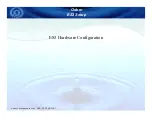
“PocketScope II“ DS60M10 Front Panel Connections
Please note the following points before connecting the “PocketScope II DS60M10 to
the circuit to be measured:
1. Like many PC-based instruments, the “PocketScope II“ DS60M10 does NOT provide galvanic (op-
tical) isolation between itself and the host PC. The GND (outer) connection on each of the BNC
connectors is connected to the GND of the host PC via the USB GND wire and cable shield.
Normal scope probe leads have a direct connection between the probe GND clip and the BNC
GND connection and so are effectively earthed via the host PC. This can also apply to notebook
PCs where some other IO connector is wired to other equipment that is earthed (for example a
USB connection to a printer).
In such a situation, connecting the GND lead of the scope probe to a voltage source can cause
excess current to flow down the GND circuit of the “PocketScope II“ DS60M10 and host PC
which may blow the internal protection fuse of the “PocketScope II“ DS60M10 or in a serious
case may damage the host PC or circuit under test.
To avoid this, please take care that the
GND clip of any attached scope probes are only attached to signals that are floating or at
GND potential.
If in doubt, check if a voltage differential exists between the GND of the scope
and the GND of the equipment being tested using a multi-meter set to measure volts, before
making any connections between the scope and the equipment.
2. Please observe that the maximum input voltages to the “PocketScope II“ DS60M10 inputs are
as follows:
Ch A, Ch B
±50 VDC (35 VAC
RMS
)
Out/Ext Trig In
±5 V
3. Do not connect any external signal to the “trigger in“/“compensation out“ connector when the
Trigger input is not active (i. e. do not connect an external signal when the green LED next to the
“trigger in“/“compensation out“ connector is off).
Getting Started Guide
Congratulations on your purchase of the “PocketScope II“ DS60M10 multi-function instrument.
This guide contains the
specifications and installation
procedure for the “PocketScope II“
DS60M10 drivers and application software.
The “PocketScope II“ DS60M10 combines the functions of
oscilloscope, data logger, spectrum
analyzer, volt meter, and frequency meter into a single instrument.
“PocketScope II“ DS60M10 EasyScope III (oscilloscope and data logging) software for Windows
and MAC OS X can be downloaded royalty-free from:
https://www.meilhaus.de/downloads
➠
PocketScope
Important Information.
Please read before use!
!
CHA/input
channel A
CHB/input
channel B
Trigger input/
compen sation output
What’s In the Box?
Please check that the box contains the
• 1x “PocketScope II“ DS60M10 instrument
following items:
• 1x instrument carrying soft case
• 1x USB cable
• This quick start guide
Hardware Features
•
Combined oscilloscope, data logger, spectrum analyzer, frequency meter, voltage meter functions.
• 10/8 bit data streaming simultaneously on both channels.
• Sampling rate: Oscilloscope: 60 MSamples/s maximum on both channels, simultaneous.
Data logger: Up to 1 KSamples/s.
• Maximum input voltage ±50 VDC (35 VAC
RMS
).
• AC/DC coupling.
• Edge, min/max, pulse width and delayed trigger modes.
• Analog Bandwidth - 5MHz.
• Support for x1 and x10 probes.
• Self powered USB interface (500 mA) - no external power supply required.
• Instrument carrying soft case included.
• Attractive enclosure with rubberized mouldings.
• Dimensions (mm) 116 (W) x 30 (H) 100 (D). Weight: 0.41 kg (excluding cable).
EasyScope III Software Features
Oscilloscope
• 2 oscilloscope channels.
• Time base – 100 ns/div…200 ms/div.
• Y-scale 25 mV/div…5 V/div.
• On Screen X and Y measurement cursors.
• FFT spectrum analyzer display on both channels.
• Meter displays - min., max., mean, true RMS voltage and frequency.
• Auto-set function.
• Save captured data as CSV or BMP files.
• Third channel selectable as trigger input or probe compensation output
(2.5 V square wave at 1 kHz).
Data logger
• 2 data logging channels.
• Sampling rate up to 1 ms (1000 Samples/s).
• Input saturation ranges from 0.1 V…20 V.
• Save captured data as CSV or BMP files.
• Import from previously saved CSV files.
Getting Started
The “PocketScope II“ DS60M10 requires device drivers to be installed on your PC to enable
communication with the instrument. Drivers should be installed prior to installing the EasyScope
III application. The “PocketScope II“ DS60M10 requires up to 500mA from the USB port. It is
recommended to connect the “PocketScope II“ DS60M10 directly to a USB port on the PC and
not through a USB hub.
Windows Driver Installation
Driver installation can be completed in one of two ways:
1. The latest “PocketScope II“ DS60M10 device drivers are available through the Microsoft
Windows Update service. Simply plug in the “PocketScope II“ DS60M10. When the ”Found
New Hardware“ Wizard appears, allow it to find the drivers from the Windows Update service.






















